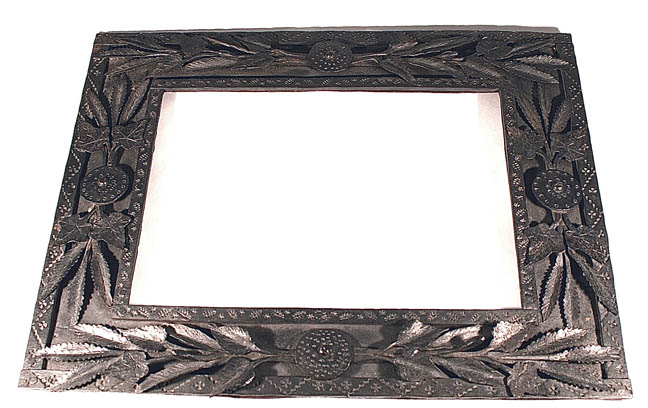

Title: European Metal Frame/Antique
Shipping: $29.00
Artist: N/A
Period: Unassigned
History: N/A
Origin: N/A
Condition: Museum Quality
Item Date: N/A
Item ID: 797
Beautiful European Metal Antique Frame, circa 19th Century. Steel metal frame with applied floral and ornament design. This frame is exquisitely hand carved. This would look awesome in a collection of older frames.
Link: http://en.wikipedia.org/wiki/Picture_frame
Picture frames evolved from the borders which appeared 3-4,000 years ago on vase and tomb paintings, and later on mosaics, enclosing narrative scenes and decorative panels. Early Christian art adapted these to the carved edgings of ivory book covers and diptychs, and finally of altarpieces. By this time the function of the frame had changed: not merely a decorative boundary, it protected and emphasized the work it held, and might have a strongly symbolic aspect. The gold and gems of early altar frames suggested the glories of Heaven; and the elaborate altarpieces developed in fourteenth- and fifteenth-century Italy imitated a mediaeval cathedral in cross-section, the 'nave', 'aisles', 'crypt' and so on each holding a painted fraction of the whole work. These ecclesiastical settings were the first real picture frames; they were followed in the early Renaissance by court frames, commissioned by monarchs and the nobility for purposes of status and propaganda. Such frames indicated power and wealth by the magnificence of their workmanship and often too, by symbolic motifs. Secular frames followed: everyday versions of court frames, produced in increasing quantities from the 14th century to the present, and in all degrees of cost or elaboration. These types and their evolution may be classified by their nationality: each country developing characteristic forms, of which the most successful might influence those of other countries - the Italian Renaissance cassetta frame, the 18th century French Rococo frame (see A History of the European fame, a study by nationality). They may also be divided across national boundaries, by style: renaissance, Mannerist, the polished wooden cabinetmaker's frame, Baroque, Palladian and Rococo, the Roman 'Salvator Rosa', Neoclassical frames, and the academic or artists' frames of the nineteenth- and twentieth-centuries.